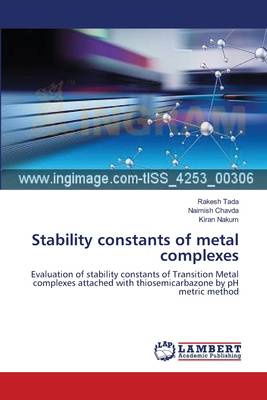
- Afhalen na 1 uur in een winkel met voorraad
- Gratis thuislevering in België vanaf € 30
- Ruim aanbod met 7 miljoen producten
- Afhalen na 1 uur in een winkel met voorraad
- Gratis thuislevering in België vanaf € 30
- Ruim aanbod met 7 miljoen producten
Zoeken
Stability constants of metal complexes
Evaluation of stability constants of Transition Metal complexes attached with thiosemicarbazone by pH metric method
Rakesh Tada, Naimish Chavda, Kiran Nakum
Paperback | Engels
€ 39,45
+ 78 punten
Omschrijving
The work presented in the Book entitled "Stability constants of metal complexes" can be summarized as below. The practical proton-ligand and metal-ligand stability constants were determined by Calvin-Bjerrum titration technique using nitric acid and constant ionic strength was maintained with sodium nitrate. It was pointed out by Irving and Rossotti, that it is neither necessary to convert pH meter reading "B" to stoichiometric hydrogen ion concentration nor to know the stoichiometric concentration of the neutral salt added to maintain constant ionic strength. The method is valid both in water and water-dioxane medium. The nitrate ion has very slight complexing tendency and the competition between nitrate ion and the ligand under study is of minor importance. This may be studied by comparing the stabilities of complexes of series of metal ions with a given ligand. For a given ligand, irrespective of its nature, the order of stability constants of complexes of bivalent ions of the first transition series are usually in the natural orders (some times called the Irving-Williams order). Cu(II)>Ni(II)>Co(II)
Specificaties
Betrokkenen
- Auteur(s):
- Uitgeverij:
Inhoud
- Aantal bladzijden:
- 60
- Taal:
- Engels
Eigenschappen
- Productcode (EAN):
- 9783659290466
- Verschijningsdatum:
- 14/03/2014
- Uitvoering:
- Paperback
- Formaat:
- Trade paperback (VS)
- Afmetingen:
- 152 mm x 229 mm
- Gewicht:
- 99 g

Alleen bij Standaard Boekhandel
+ 78 punten op je klantenkaart van Standaard Boekhandel
Beoordelingen
We publiceren alleen reviews die voldoen aan de voorwaarden voor reviews. Bekijk onze voorwaarden voor reviews.











